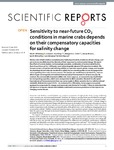Sensitivity to near-future CO₂ conditions in marine crabs depends on their compensatory capacities for salinity change
| dc.contributor.author | Whiteley, NM | |
| dc.contributor.author | Suckling, CC | |
| dc.contributor.author | Ciotti, Benjamin | |
| dc.contributor.author | Brown, J | |
| dc.contributor.author | McCarthy, Ian D., | |
| dc.contributor.author | Gimenez, Luis, | |
| dc.contributor.author | Hauton, Chris, | |
| dc.date.accessioned | 2018-10-23T11:56:25Z | |
| dc.date.issued | 2018-10-23 | |
| dc.identifier.issn | 2045-2322 | |
| dc.identifier.issn | 2045-2322 | |
| dc.identifier.other | 15639 | |
| dc.identifier.uri | http://hdl.handle.net/10026.1/12591 | |
| dc.description | No embargo required. | |
| dc.description.abstract |
<jats:title>Abstract</jats:title><jats:p>Marine crabs inhabit shallow coastal/estuarine habitats particularly sensitive to climate change, and yet we know very little about the diversity of their responses to environmental change. We report the effects of a rarely studied, but increasingly prevalent, combination of environmental factors, that of near-future <jats:italic>p</jats:italic>CO<jats:sub>2</jats:sub> (~1000 µatm) and a physiologically relevant 20% reduction in salinity. We focused on two crab species with differing abilities to cope with natural salinity change, and revealed via physiological and molecular studies that salinity had an overriding effect on ion exchange in the osmoregulating shore crab, <jats:italic>Carcinus maenas</jats:italic>. This species was unaffected by elevated CO<jats:sub>2</jats:sub>, and was able to hyper-osmoregulate and maintain haemolymph pH homeostasis for at least one year. By contrast, the commercially important edible crab, <jats:italic>Cancer pagurus</jats:italic>, an osmoconformer, had limited ion-transporting capacities, which were unresponsive to dilute seawater. Elevated CO<jats:sub>2</jats:sub> disrupted haemolymph pH homeostasis, but there was some respite in dilute seawater due to a salinity-induced metabolic alkalosis (increase in HCO<jats:sub>3</jats:sub><jats:sup>−</jats:sup> at constant <jats:italic>p</jats:italic>CO<jats:sub>2</jats:sub>). Ultimately, <jats:italic>Cancer pagurus</jats:italic> was poorly equipped to compensate for change, and exposures were limited to 9 months. Failure to understand the full spectrum of species-related vulnerabilities could lead to erroneous predictions of the impacts of a changing marine climate.</jats:p> | |
| dc.format.extent | 0-0 | |
| dc.format.medium | Electronic | |
| dc.language | en | |
| dc.language.iso | en | |
| dc.publisher | Nature Research (part of Springer Nature) | |
| dc.subject | Acid-Base Equilibrium | |
| dc.subject | Animals | |
| dc.subject | Aquatic Organisms | |
| dc.subject | Bicarbonates | |
| dc.subject | Brachyura | |
| dc.subject | Carbon Dioxide | |
| dc.subject | Gene Expression Regulation | |
| dc.subject | Hemolymph | |
| dc.subject | Hydrogen-Ion Concentration | |
| dc.subject | Osmosis | |
| dc.subject | Salinity | |
| dc.subject | Seawater | |
| dc.title | Sensitivity to near-future CO₂ conditions in marine crabs depends on their compensatory capacities for salinity change | |
| dc.type | journal-article | |
| dc.type | Journal Article | |
| dc.type | Research Support, Non-U.S. Gov't | |
| plymouth.author-url | https://www.ncbi.nlm.nih.gov/pubmed/30353120 | |
| plymouth.issue | 1 | |
| plymouth.volume | 8 | |
| plymouth.publication-status | Published online | |
| plymouth.journal | Scientific Reports | |
| dc.identifier.doi | 10.1038/s41598-018-34089-0 | |
| plymouth.organisational-group | /Plymouth | |
| plymouth.organisational-group | /Plymouth/Faculty of Science and Engineering | |
| plymouth.organisational-group | /Plymouth/Faculty of Science and Engineering/School of Biological and Marine Sciences | |
| plymouth.organisational-group | /Plymouth/REF 2021 Researchers by UoA | |
| plymouth.organisational-group | /Plymouth/REF 2021 Researchers by UoA/UoA07 Earth Systems and Environmental Sciences | |
| plymouth.organisational-group | /Plymouth/Users by role | |
| plymouth.organisational-group | /Plymouth/Users by role/Academics | |
| dc.publisher.place | England | |
| dcterms.dateAccepted | 2018-10-09 | |
| dc.rights.embargodate | 2019-11-27 | |
| dc.identifier.eissn | 2045-2322 | |
| dc.rights.embargoperiod | Not known | |
| rioxxterms.versionofrecord | 10.1038/s41598-018-34089-0 | |
| rioxxterms.licenseref.uri | http://www.rioxx.net/licenses/all-rights-reserved | |
| rioxxterms.licenseref.startdate | 2018-10-23 | |
| rioxxterms.type | Journal Article/Review |


